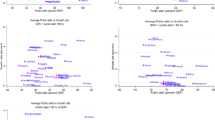Abstract
This research offers new insights into the effect of the Global Financial Crisis of 2007–2009 on the countries that used to be part of the Soviet bloc by focusing on a cross-regional comparison. Twenty-eight countries are grouped according to different criteria and the corresponding vulnerability of each group is compared. The research links the variability in the groups’ responses to the dependence on trade with the European Union, the degree of the transition and economic freedom, and the sectoral composition of GDP. The research finds that what is considered to be an advantage for a transition economy during “normal” times -- high degree of economic freedom and trade liberalization, financial system sophistication, and a well-developed service sector -- became a disadvantage during the crisis.
Similar content being viewed by others
Notes
CIS includes twelve out of fifteen former Soviet Union Republics -- Armenia, Azerbaijan, Belarus, Georgia, Kazakhstan, Kyrgyzstan, Moldova, Russian Federation, Tajikistan, Turkmenistan, Ukraine, and Uzbekistan – all but the Baltics (Estonia, Latvia, Lithuania).
CEE includes all the Eastern European countries west of post-WWII border with the former Soviet Union, countries of the former Yugoslavia, and the three Baltic states.
Stock market inception was used as a proxy for the starting date.
These are the countries that were independent prior to the transition.
Eastern Commonwealth of Independent States excludes Commonwealth of Independent States of Central Asia and Caucasus.
Financial reforms started during 1989 – 1992.
Financial reforms started during 1993–1996.
Financial reforms started after 1998.
It is important to note that the three Baltic countries retained the trade relations with their Western neighbors even after they were integrated into the Soviet Union. Most of these “trade” transactions, however, were black market activities.
Pearson correlation coefficient is 0.82 (author’s calculations).
References
Berglöf, E., Korniyenko, E., Plekhanov, A., & Zettelmeyer, J. (2009). Understanding the crisis in emerging Europe, EBRD Working Paper No. 109. http://www.ebrd.com/downloads/research/economics/workingpapers/wp0109.pdf. Accessed on February 28, 2013.
Blot C., Le Bayon, S., Lemoine, M., & Levasseur, S. (2009). Quantifying the Impact of Financial Crisis on the Real Sphere for France and the United States, http://www.univ-orleans.fr/gdre09/articles/Blot_alii_english.pdf. Accessed on February 28, 2013.
Brezigar-Masten, A., Coricelli, F., & Masten, I. (2010). Financial integration and financial development in transition economies: What happens during financial crises? Centre d’Economie de la Sorbonne, Documents de travail du Centre d’Economie de la Sorbonne No. 10021. http://halshs.archives-ouvertes.fr/docs/00/46/94/99/PDF/10021.pdf. Accessed on February 28, 2013.
Calvo, G. (2006). Monetary Policy Challenges in Emerging Markets: Sudden Stop, Liability Dollarization and Lender of Last Resort, NBER Working Papers, 12788. http://cid.bcrp.gob.pe/biblio/Papers/NBER/2006/Diciembre/w12788.pdf. Accessed on February 28, 2013.
Chang, R., & Velasco, A. (1998). The Asian Liquidity Crisis, Economics Research Reports, RR No. 98–27, C.V. Starr Center for Applied Economics, Department of Economics, New York University, New York. http://econ.as.nyu.edu/docs/IO/9381/RR98-27.PDF. Accessed on February 28, 2013.
De Melo, M., Denizer, C., & Gelb, A. (1997). From plan to market: patterns of transition. In Bléjer, M. I., & Skreb, M. (Eds.). (2006). Macroeconomic stabilization in transition economies. (pp.17-72). Cambridge University Press.
Dell’Ariccia, G., Detragiache, E., & Rajan, R. (2008). The real effect of banking crises. Journal of Financial Intermediation, 17(1), 89–112.
EBRD Economic statistics and forecasts (1996, 2006-2011). http://www.ebrd.org. Online Database. Accessed on May 6, 2012.
EBRD Transition Report (2009). Transition in Crisis? http://www.ebrd.com/downloads/research/transition/TR09.pdf. Accessed on March 11, 2013.
EBRD/World Bank (2010). The Crisis Hits Home: Stress-Testing Households in Europe and Central Asia. http://siteresources.worldbank.org/ECAEXT/Resources/258598-1256842123621/6525333-1259681048367/WorldBank_Crisis_Report.pdf. Accessed on March 11, 2013.
Economic Freedom Index (2006). Heritage Foundation/The Wall Street Journal. [on-line]. http://www.heritage.org/index/. Accessed on February 15, 2014.
Edwards, S. (2008). Financial Openness, Currency Crises, and Output Losses. In Edwards, S. & Garcia, M. G. P. (Eds.), Financial Markets Volatility and Performance in Emerging Markets, (pp. 97–120). NBER books.
Furceri, D., & Zdzienicka, A. (2011). The real effect of financial crises in the European transition economies. Economics of Transition, 19, 1–25.
Gevorkyan, A. K. (2011). Innovative fiscal policy and economic development in transition economies. Oxford: Routledge.
Hartwell C. A. (2012). Financial Liberalization and Crises in Transition Economies: What Have 20+ Years Taught Us? Institute for Emerging Market Studies. http://courses.essex.ac.uk/ec/ec330/lecture_presentations/Financial%20Liberalization%20and%20Crises%20in%20Transition%20Economies%20NES%20FINAL.pdf. Accessed on March 11, 2013.
Hutchison, M., & Ilan, N. (2005). How bad are twins? Output costs of currency and banking crises. Journal of Money, Credit and Banking, 37(4), 725–752.
International Monetary Fund News Briefs. (2000, 2001, 2002, 2007). http://www.imf.org/external/news/default.aspx?nb. Accessed on March 11, 2013.
Reinhart, C., & Rogoff, K. (2009). The aftermath of financial crises. American Economic Review, 99(2), 466–472.
Shelburne, R. C. (2008). Current Account Deficits in European Emerging Markets, UNECE Discussion Paper No. 2008.2 http://www.unece.org/fileadmin/DAM/oes/disc_papers/ECE_DP_2008-2.pdf. Accessed on March 11, 2013.
Stiglitz, J. (1998). More Instruments and Broader Goals: Moving Toward the Post Washington Consensus, WIDER Annual Lecture, Helsinki. http://www.wider.unu.edu/publications/annual-lectures/en_GB/AL2/. Accessed on March 11, 2013.
Williamson, J. (1997) The Washington Consensus Revisited, In Emmerij (ed).
World Bank Development Indicators Database. (2006–2011). http://data.worldbank.org/data-catalog/world-development-indicators. Accessed on March 11, 2013.
Author information
Authors and Affiliations
Corresponding author
Rights and permissions
About this article
Cite this article
Shostya, A. The Effect of the Global Financial Crisis on Transition Economies. Atl Econ J 42, 317–332 (2014). https://doi.org/10.1007/s11293-014-9418-2
Published:
Issue Date:
DOI: https://doi.org/10.1007/s11293-014-9418-2




